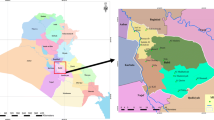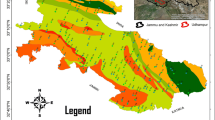Abstract
The state of Punjab—a part of the Indus basin of the Indian subcontinent has an excellent net work of irrigation facilities. However, due to intensive cultivation it is facing a major problem with respect to quality of groundwater for irrigation. In the present investigation, geo-referenced groundwater samples were analysed to map water quality using geographical information system. Electrical conductivity varied from 0.418 to 5.754 dS m−1 with an average of 1.365 dS m−1. The carbonate ranged between 0 and 120 mg L−1, whereas bicarbonate ranged from 5 to 1,000 mg L−1. Chloride varied from 7 to 2,347 mg L−1. Calcium plus magnesium ranged from 12 to 1,216 mg L−1 with a mean value of 169 mg L−1. Sodium adsorption ratio ranged between 0.0 and 34.78 with an average of 2.66 meq L−1/2. Residual sodium carbonate varied from 0 to 21.30 meq L−1 with a standard deviation of 2.24. The Geographic Information System (GIS)-based mapping indicated that water in suitable category spatially covered 45.7 % of the state which is located mostly in the sub-mountain (Siwalik Hills), north-eastern undulating and piedmont and alluvial plain agro-eco-subregions. Marginally suitable groundwater spatially covered 46.1 % in the central alluvial plain and south-western alluvial plain agro-eco-subregions. Unsuitable groundwater covered 8.2 % of the state, mostly in the erstwhile sodic soils areas in the central alluvial plain and south-western alluvial plain agro-eco-subregions. GIS-based maps are effective in identifying hot spots which need immediate attention and call for strategic planning for sustainable management.





Similar content being viewed by others
References
Ahmed SS, Mazumdar QH, Jahan CS, Ahmed M, Islam S (2002) Hydrochemistry and classification of groundwater, Rajshahi city corporation area, Bangladesh. J Geol Soc India 60:411
Anonymous (1999) Major ions in water. Training module no. WQ-28. Hydrology project, CSMRS building, New Delhi-110018, India
APHA (1998) Standard methods for the examination of water and waste waters, 20th edn. APHA, Washington, DC
Bajwa MS, Hira GS, Singh NT (1986) Effect of sustained saline irrigation on soil salinity and crop yields. Irrig Sci 7:27–34
Bali SK, Kumar R, Hundal HS, Singh K, Singh B (2010) GIS-aided mapping of DTPA extractable Zinc and soil characteristics in the state of Punjab-NW India. J Indian Soc Soil Sci 58:189–199
Bhumbla DR, Abrol IP (1972) Is your water suitable for irrigation? Indian Farm 22:15–17
Brar SPS, Singh Balwinder (1985) Changes in quality of underground irrigation waters of the Punjab state. Indian J Environ Health 27:262–265
Brar JS, Singh Balwinder (1993) Underground irrigation water quality in south-western districts of Punjab. J Res PAU 30:15–23
CGWB (1997) Inland groundwater salinity in India. Government of India, ministry of Water Resources, Central Ground Water Board, Faridabad, Haryana, India-121001, p 62
CGWB (2008) Annual report, Central Ground Water Board, NH-IV, Bhujal Bhawan, Faridabad, Haryana, India-121001
Eaton FM (1950) Significance of carbonates in irrigation waters. Soil Sci 3:123–133
Emerson WW, Bakker AC (1973) The comparative effect of exchangeable Ca: Mg and Na on some soil physical properties of red brown earth soils. 2. The spontaneous dispersion of aggregates in water. Aust J Soil Res 11:151–152
Ganapathy C, Ernest ANS (2004) Water quality assessment using web based GIS and distributed database management systems. Environ Infor Arch 2:938–945
Ghafoor A, Ullah F, Abdullah M (1990) Use of high Mg brackish water for reclamation of saline sodic soil. 1. Soil improvement. Pakistan J Agri Sci 27:294–298
Ghafoor A, Azam M, Shoaib M (1993) Characterization of tube well and hand pump waters in the Faisalabad tehsil. Pakistan J Agri Sci 8:1–2
Goel PK (2006) Water pollution, causes, effects and control, 2nd revised edition. New Age International Publishers, New Delhi
Hundal HS, Kumar R, Singh K, Singh D (2007) Occurrence and geochemistry of arsenic in groundwater of Punjab, Northwest India. Commun Soil Sci Plan Anal 38:2257–2277
Hundal HS, Singh D, Singh K, Kumar R (2009) Contribution of nutrients through tubewell irrigation water to wheat and rice in different landform zones of Punjab. J Indian Soc Soil Sci 57:97–99
Hundal HS, Singh K, Singh D, Kumar R (2012) Arsenic mobilization in alluvial soils of Punjab, North-West India under flood irrigation practices. Environ Earth Sci. ISSN 1866-6280. doi:10.1007/s12665-012-1999-y
Jalal A, Tabbal Al, Kamel K, Zboon Al (2012) Suitability assessment of groundwater for irrigation and drinking purpose in the northern region of Jordan. J Environ Sci Techno 5:274–290
Jalota SK, Arora VK (2002) Model-based assessment of water balance components under different cropping systems in north-west India. Agric Water Manage 57:75–87
Joshi DM, Kumar A, Agarwal N (2009) Assessment of the irrigation water quality of river Ganga in Haridwar District. Rasayan J Chem 2:285–292
Kanwar JS, Chaudhry ML (1968) Effect of Mg on the uptake of nutrients from the soil. J Res PAU 3:309–319
Kelley WP (1951) Alkali soils: their formation, properties and reclamation. Van Nostrand Reinhold, New York
Kumar M, Kumari K, Ramanathan AL, Saxena R (2007) A comparative evaluation of groundwater suitability for irrigation and drinking purposes in two agriculture dominated districts of Punjab, India. J Environ Geol 53:553–574
Kumar R, Singh B, Kaur P, Beri V (2008) Planning for precision farming in different agro-ecological sub-regions of Punjab—role of natural resources in agricultural research, planning, development, and transfer of technology. Department of Soils, Punjab Agricultural University, Ludhiana-141001, India, p 72, 13 maps
Kumar R, Singh B, Hundal HS, Singh K, Singh Y (2010) Geo spatial quality of underground water of the Punjab. Department of Soils, Punjab Agricultural University, Ludhiana-141004, India, p 72, 26 figures
Minhas PS, Gupta RK (1993) Conjunctive use of saline and non-saline waters I. Response of wheat to initial salinity profiles and salinization patterns. Agri Water Manag 23:125–137
Minhas PS, Jalota SK, Arora VK, Jain AK, Vashisht KK, Choudhary OP, Kukal SS, Vashisht BB (2010) Managing water resources for ensuring sustainable agriculture: situational analysis and options for Punjab. Research bulletin 2/2010, directorate of research, PAU, Ludhiana-141004, India, p 40
Parihar SS, Khepar SD, Singh R, Grewal SS, Sondhi SK (1993) Water resources of Punjab: a critical concern for the future of its agriculture. Research bulletin, Directorate of research, PAU, Ludhiana-141004, India, p 54
Pervaiz Z (2005) Characterization of irrigation quality of ground water in union council Gakhra Kalan, district Gujrat—Pakistan. Int J Agric Biol 7(2):269–271
Sidhu GS, Walia CS, Tarsem L, Rana KPC, Sehgal JL (1995) Soils of Punjab for optimising land use. NBSS Publ. 45 (Soils of India Series 4) National Bureau of Soil Survey and Land Use Planning, Nagpur, India. p 75, 2 sheets soil map (1:500,000 scale)
Singh B, Bishnoi SR (2004) Underground irrigation water quality in Muktsar district of Punjab. J Res Punjab Agric Univ 41(4):442–446
Singh B, Bishnoi SR (2005) Quality of sub-soil irrigation waters in three development blocks of Ferozepur district of Punjab. J Res Punjab Agri Univ 42(3):280–284
Singh B, Bishnoi SR (2006) Changes in quality of underground irrigation water in Nihal Singh Wala block of Moga district of Punjab. J Res Punjab Agric Univ 43:19–20
Singh B, Kumar B (2007) Quality of underground irrigation water in Ferozepur district of Punjab. J Res Punjab Agric Univ 44(4):297–300
Singh B, Rana DS, Bajwa MS (1977) Salinity and sodium hazards of underground irrigation waters of the Bathinda district (Punjab). J Indian Ecol 4:32–41
Thomas A, Verma VK, Sood A, Litoria PK, Sharma PK, Ravindran KVl (1995) Hydrogeology of Talwandi Sabo Tehsil, Bathinda District (Punjab). J Indian Soc Remote Sens 23:47–56
Wadia DN (1979) Geology of India. Tata Mc Graw Hill Publication, New Delhi
White JG, Welch RM, Norvell WA (1997) Soil zinc map of USA using geostatistics and geographic information system. Soil Sci Soc Am J 61:185–194
Author information
Authors and Affiliations
Corresponding author
Rights and permissions
About this article
Cite this article
Kumar, R., Singh, K., Singh, B. et al. Mapping groundwater quality for irrigation in Punjab, North-West India, using geographical information system. Environ Earth Sci 71, 147–161 (2014). https://doi.org/10.1007/s12665-013-2421-0
Received:
Accepted:
Published:
Issue Date:
DOI: https://doi.org/10.1007/s12665-013-2421-0




